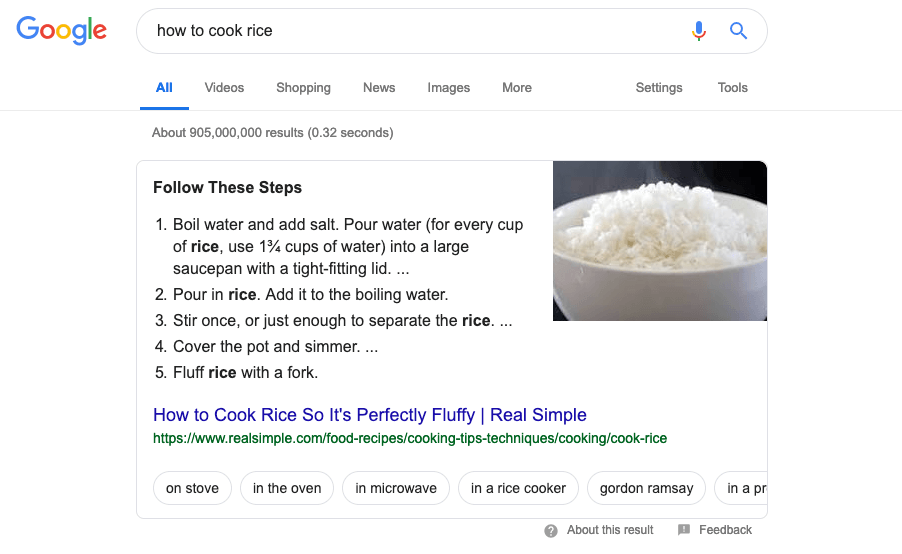What is Position Zero? How to Win at SEO with Featured Snippets
Being the top-ranked search result has been the search engine optimization (SEO) goldmine for a while. But now it's time for the top-ranked spot to move over: Position zero is the new top-ranked spot. Yeah, SEO has changed again. There are always new tactics and new technology, and it can be a struggle to keep up.
Being the top-ranked search result has been the search engine optimization (SEO) goldmine for a while. But now it’s time for the top-ranked spot to move over: Position zero is the new top-ranked spot.
 Yeah, SEO has changed again. There are always new tactics and new technology, and it can be a struggle to keep up. Position zero is just the latest tweak that Google has rolled out to help users find the content they need.
We’ll cover all the details of what position zero is, why it matters, and how you can get there, based on the “Getting Into Position Zero” webinar by SEO pro Lindsay Halsey of Pathfinder SEO.
Yeah, SEO has changed again. There are always new tactics and new technology, and it can be a struggle to keep up. Position zero is just the latest tweak that Google has rolled out to help users find the content they need.
We’ll cover all the details of what position zero is, why it matters, and how you can get there, based on the “Getting Into Position Zero” webinar by SEO pro Lindsay Halsey of Pathfinder SEO.
 Position zero can come in different forms:
Position zero can come in different forms:
 Yeah, SEO has changed again. There are always new tactics and new technology, and it can be a struggle to keep up. Position zero is just the latest tweak that Google has rolled out to help users find the content they need.
We’ll cover all the details of what position zero is, why it matters, and how you can get there, based on the “Getting Into Position Zero” webinar by SEO pro Lindsay Halsey of Pathfinder SEO.
Yeah, SEO has changed again. There are always new tactics and new technology, and it can be a struggle to keep up. Position zero is just the latest tweak that Google has rolled out to help users find the content they need.
We’ll cover all the details of what position zero is, why it matters, and how you can get there, based on the “Getting Into Position Zero” webinar by SEO pro Lindsay Halsey of Pathfinder SEO.
What Is Position Zero?
[pullquote]Position zero is the information Google offers at the very top of the search results. Position zero is also called the featured snippet, and is exactly that: a featured snippet of content that directly answers a search query.[/pullquote] Position zero is placed above the top ranking search result and displayed differently. As Google explains about featured snippets in search, “What’s different with a featured snippet is that it is enhanced to draw user attention on the results page.” Here’s what a position zero result looks like: Position zero can come in different forms:
Position zero can come in different forms:
- Paragraph – The most common form is a 40- to 60-word block of content that explains the search query.
- List – A bulleted list of steps explaining how to do the search query.
- Table – A chart of data, such as a conversion table for cups to ounces.
Why Is Position Zero Valuable?
Marketers initially protested that featured snippets would hurt their traffic and people wouldn’t visit their sites. But position zero doesn’t hurt stats. In fact, position zero has been shown to vastly improve stats, including visits, click-throughs, and conversions. [pullquote]When it comes to SEO, zero is the new number one.[/pullquote] In addition to boosting traffic and sales, position zero is great for establishing brand expertise. When your business provides the definitive answer to a question, that’s a powerful statement about your brand. Position zero results are also used in voice search, so that can be an incredibly helpful boost as voice search becomes more common.Good Content Always Wins SEO
Before we dive into the specifics, if you’re frustrated by the constant changes with SEO, just remember that good content always wins. Every time there’s a shift in strategy or a new feature, everybody scrambles. But if you make good content, you don’t have to worry that much. Yes, there may be things to tweak or reassess, but in general, quality content that’s helpful to users is going to do well in search engine rankings. So make adjustments to the latest SEO changes, but don’t sweat it.How Do I Achieve Position Zero Results?
So now that you know the what and why of position zero, let’s talk about how.1. Identify Position Zero Opportunities
The first step in trying to land position zero is to identify the right opportunities. Not every search result has a featured snippet. So you want to find keyword phrases that have a featured snippet or that lend themselves well to featured snippets. It can also be helpful to start with keywords you already rank well for. Most featured snippets come from high ranking results (good content always wins).2. In-Depth Content for the Win
Next, you need to write really good content. When it comes to winning at SEO, there aren’t any shortcuts for ranking except quality content that helps users. This should be obvious, but a few specific tips might help:- Longer is better: You should target content with at least 2,000 words.
- Evergreen: There’s no point in doing all this work for something that will change next week. Pick a topic with some staying power.
- Unpack the topic: Go in-depth and really explore multiple facets of the topic. Explain things thoroughly and don’t assume prior knowledge.
- Context is king: Remember that Google now uses latent semantic indexing (LSI), which means it understands how words relate. So it’s no longer helpful to stuff the content with your keyword phrase. Use related phrases and synonyms to show a breadth of understanding about the topic.
- Snippet bait: Most importantly, you need to create the content that will ideally comprise the featured snippet. You can aim for one of the common types (paragraph, list, or table) and directly answer the question in your chosen keyword phrase.
3. Publish With Good On-Site SEO
In addition to the content, you need to make sure the rest of your page is optimized for search. That means:- Page titles & meta descriptions: Using your focused keywords.
- H1-H5 tags: Properly use the tags not only to help visually, but also to properly structure your content so the search engines can understand it.
- Alt tags: Offer helpful (note: not keyword stuffed) alt tags on images.
- Internal links: Be sure to link to other helpful content.
4. Don’t Forget Off-Site SEO
This primarily comes down to link building and social media. You want other folks to link to your content. The best way to do that is to rely on your professional relationships. Ask folks to link to your content. This is where good content always wins, because people love to link to good content. Sometimes it’s just a matter of offering helpful content at the right moment. For example, if you’re a guest on a podcast and you touch on an important topic, you could later recommend that the host link to your post on that important topic to offer visitors more in-depth details.SEO Is Always About Helpful Content
So position zero is just the latest and greatest in the world of SEO. It’s a good place to be and something that can help your business and your clients. Watch the free webinar with Lindsay Halsey for more insights. Remember that helpful content always wins.Learn more with SEO Bootcamp
Want to learn more about SEO? Get 12 hours of online SEO training with SEO expert Lindsay Halsey with the SEO Bootcamp training course.
Learn more
Sign up now — Get SolidWP updates and valuable content straight to your inbox
Sign up
Placeholder text
Placeholder text
Get started with confidence — risk free, guaranteed
